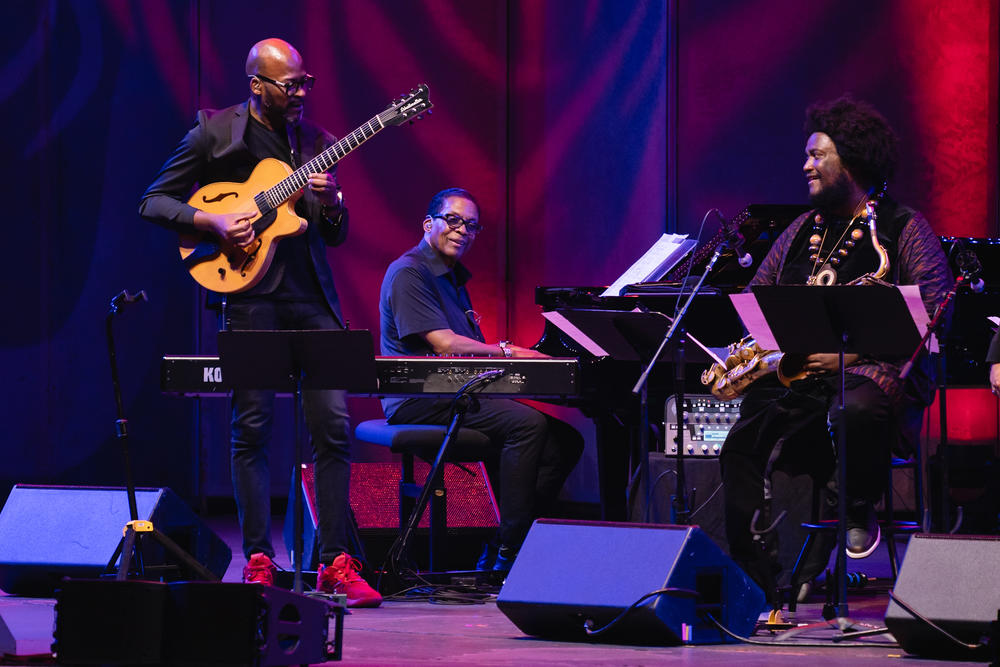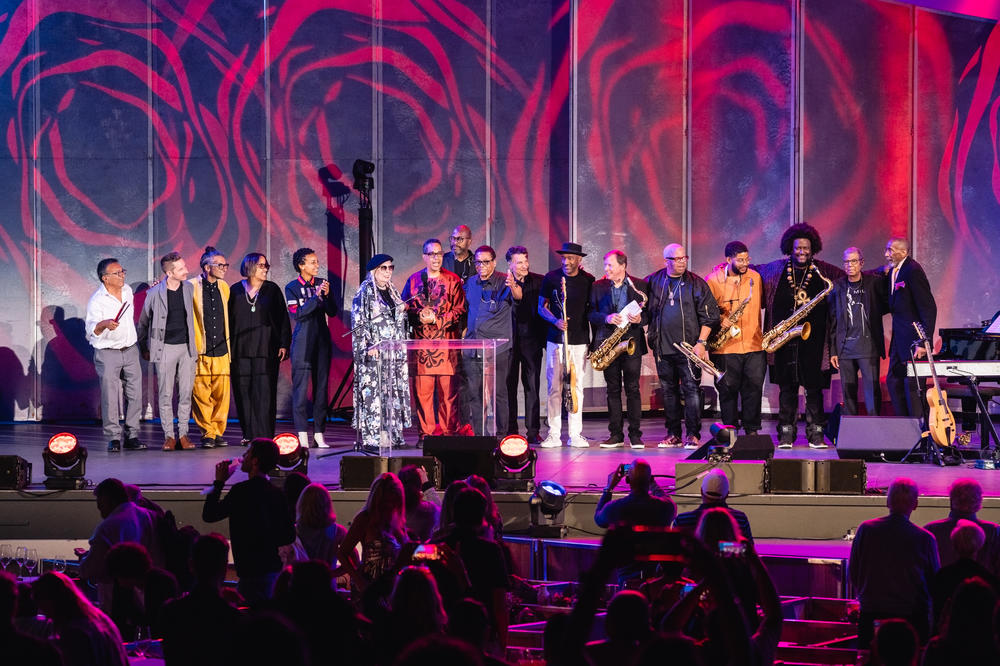Section Branding
Header Content
Wayne Shorter, From Here to Eternity
Primary Content
Herbie Hancock walked onstage at the Hollywood Bowl on Wednesday night leading two small children by the hand: his grandson, Dru, and Wayne Shorter's grandson, Max. Describing them as best friends, aged a year and a half apart, Hancock made the obvious parallel to his own relationship with Shorter, over more than six decades. "He loved us with courage in his heart," Hancock attested. By "us," he seemed to mean all of the roughly 11,000 people gathered before him under a clear summer sky, but more too: every member of the human race, here and beyond. Simply but pointendly, he added: "Wayne was ready for rebirth."
Shorter, who died on March 2, was a saxophonist of elliptical eloquence and a composer of farsighted and revealing imagination. Like Hancock, a brilliant pianist and frequent collaborator, he was also a practicing Buddhist. As an enlightenment belief system, it complemented Shorter's lifelong inclination toward all things cryptic and cosmic. This was mainly a stealth influence in the Hollywood Bowl concert, for which Hancock served as musical director, with a starry assortment of friends and an unbilled appearance by Joni Mitchell. It runs more deeply and forthrightly throughout Wayne Shorter: Zero Gravity, an illuminating three-part documentary released on Amazon Prime, in time for what would have been Shorter's 90th birthday.
One challenge in celebrating Shorter's legacy is the sheer expanse and variety of his creative output, which had a profound impact on the evolving jazz landscape of the last 60 years. The concert and the film ventured different solutions to this problem, if you want to call it a problem. "Herbie Hancock Celebrates Wayne Shorter" at the Hollywood Bowl rooted its subject in the familiar: a hub of relationships, a handful of touchstones. Wayne Shorter: Zero Gravity pushes toward a more ethereal and mystical appraisal of the man even as it brings his life into often granular focus. At one point Danilo Pérez, pianist in the heralded Wayne Shorter Quartet, recalls inquiring about when they might rehearse. Shorter's retort: "You can't rehearse the unknown."
Hancock, in his concert introduction, alluded to remarks like these as "Wayne-isms" — all those trippy, quippy utterances that Shorter made into a beloved trademark. "You either laugh right away," Hancock said, momentarily defaulting to the present tense, "or it takes you six months to figure out what he meant." After a beat: "But he was always right." This line met with an appreciative laugh, though it also reinforced an unspoken truth about the evening's purpose, which was to memorialize the music and spirit of a man who saw every work as unfinished, as an invitation to play. His vibrant presence in the film, and his unavoidable absence on the Hollywood Bowl stage, were two sides of the same experience — an effort to get to know the dimensions of his work in the wake of his transition, and a struggle to be comfortable with not knowing.
To that end, Pérez led an expeditionary party with the other alumni of the Quartet, bassist John Patitucci and drummer Brian Blade. In the early stretch of Wednesday's concert, they performed with Chris Potter standing in for the maestro on tenor saxophone. This offering was a welcome reminder of Shorter's revelatory mandate to the band, his insistence on ceaseless invention. Opening with the fanfare from "Witch Hunt," the quartet then recast that classic song with a sly 7/4 groove, which Potter carved up like a sand buggy rattling over a dune. "Joy Ryder" was even more cathartic, punctuated with an offbeat three-note pattern that Patitucci and Blade attacked with controlled abandon.
The most touching aspect of the Quartet reunion was the evident trace of Shorter's hand in the musicians' shared language. That trace also showed in the concert's opener, with esperanza spalding on bass and vocals, Terri Lyne Carrington on drums and Leo Genovese on piano, as on the Grammy-winning recent album Live at the Detroit Jazz Festival and a related episode of Jazz Night in America. (Kamasi Washington was the tenor saxophone surrogate for this benedictory sequence, and he brought stoical gusto to the task.)
Hancock himself naturally brought the deepest authority to the stage, especially in a sequence that matched him with bassist Ron Carter and drummer Jack DeJohnette — two more fellow travelers in the late-1960s orbit of Miles Davis. (Hancock, Carter and Shorter were all members of Davis' famed acoustic quintet; DeJohnette joined the following edition of the group, overlapping with Shorter as it transformed into a kind of avant-garde rock band.) Trumpeter Terence Blanchard, a wise and slashing presence throughout the concert, was a part of this cohort along with Washington, Potter and a young alto saxophonist named Devin Daniels, who recently graduated from the Herbie Hancock Institute of Jazz. When the horns stepped back to let Hancock stretch out on Shorter's "Dolores," all the mystery and majesty felt close at hand.
But whereas Shorter was an incorrigible explorer, often almost daring his audiences to follow the thread, Hancock is a natural communicator, and more of an entertainer. So the concert also felt tethered to considerations that Shorter himself might have willfully ignored. The Miles Davis segment included the groove tune "Eighty-One," partly in implied deference to Carter, its composer. A segment featuring Carlos Santana on guitar (with his wife, Cindy Blackman Santana, on drums) included a funk gloss on the Miles Davis tune "So What," which Shorter played but by no means defined. An extended and otherwise satisfying tribute to Weather Report, led by the electric bassist Marcus Miller, featured fewer compositions by Shorter than by his co-leader, Joe Zawinul. (Of course this included "Birdland," the band's breakaway hit.) More understandably, there was no portion of the concert that conveyed the scope of Shorter's orchestral or chamber writing, or the operatic work he made with spalding.
To the extent that these were small faults of the concert's design, there's more than enough counterbalance in the three hour-long chapters, or "portals," that constitute Wayne Shorter: Zero Gravity. The film, directed by Dorsay Alavi, has been a work in progress for more than 20 years, and its massive accumulation of footage and testimonials is not only a priceless trove but one that's expertly deployed. There are a few too many distracting animations and visual effects — at times Alavi seems not to trust the viewer's imagination, rushing to literalize every metaphor — but the material is extraordinary, and the film's thematic compass is steady and sure.
One of the most powerful sequences in the film concerns a succession of personal tragedies that befell Shorter, and what he mustered in response. The first of these was the death of his daughter, Iska, of a grand mal seizure in 1985, when she was 14. A few years later, Shorter's brother, Alan, died of a ruptured aortic aneurysm at 55. Then in 1996, his wife, Ana Maria, was among the passengers aboard TWA Flight 800, which exploded off the coast of Long Island; she was en route to Europe with a niece, who also perished, to meet up with Shorter on tour. The film presents this saga with heartbreaking detail but no excess of pathos, making its impact on Shorter feel legible, if still unimaginable. An interview clip with a television newscast around that time shows him visibly grappling with his emotions, but coming to a firm conclusion. "The reason why death happens over and over again," he says, "[is] because it is not the end."
The moment in the Hollywood Bowl concert that best evoked this poignancy was actually the cameo by Mitchell, a longtime friend and collaborator of Shorter's, and a vital presence in the film. Her triumphant recent return to the stage made it seem more than likely that she would show up for this tribute, raising the question of what song or songs she might perform. There are many smart options — in the film, producer Larry Klein makes a persuasive case for "Moon at the Window," a track from the early '80s — but Mitchell chose to sing "The Circle Game," a defining song from early in her career. Backed by a sensitive assembly that included Hancock, Blade, Patitucci and guitarist Lionel Loueke, she imbued it with a careful air of rumination.
Her lyrics to the song have always encouraged a nested series of metaphors: the spinning of a carousel is to the turning of the seasons is to the phases of the human life cycle. Crucially, this understanding frames aging and even death as part of a circularity, rather than a timeline. And while there's a necessary surrender, even a kind of captivity, in the process, Mitchell presents it as a game to be played. Watching her move slowly through the song, I thought about how intuitive it must have seemed to Shorter. And I thought about one of his final proclamations, according to his family: "It's time to go get a new body and come back to continue the mission."
Copyright 2023 WRTI . To see more, visit WRTI .



